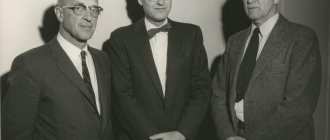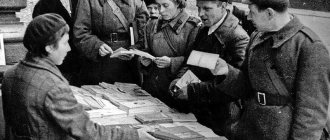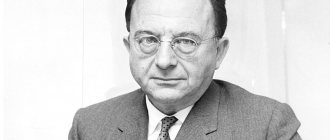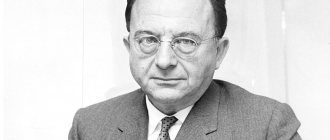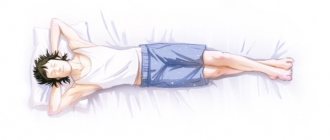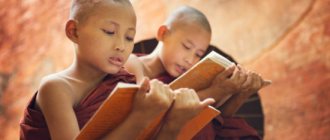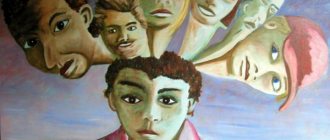Biography
The author of the technique of free association, Swiss psychologist and philosopher Carl Jung is familiar to many from the books “Man and His Symbols”, “Archetypes” and “Memories, Reflections, Dreams”.
Jung's teachings are based on the terms "introversion" and "extroversion" that he personally developed. Karl argued that each individual, depending on the dominant personality function, can be turned either to his inner self (introversion) or to the external world (extroversion). Based on this conclusion, the researcher developed psychological types of people and derived a formula for the human soul, enclosing it in a psychiatric and psychological framework. Jung's work has had a significant influence on cultural studies, comparative religion, anthropology, pedagogy and literature.
Concept of psychological types
Article on the topic
Color treatment: what colors will relieve stress, boredom and fatigue Jung introduced the concepts of extraversion and introversion as the main types of personality orientation (ego orientation). According to his theory, which has been richly supported by practice around the world for about 100 years, both orientations exist in a person simultaneously, but one of them usually leads. Everyone knows that an extrovert is more open and sociable, while an introvert is all about himself. This is the popular version of these concepts. In fact, everything is not quite like that; extroverts can also be closed. An extrovert's psychic energy is directed outward - towards the situation and the people around him, his partners. He influences all this himself, as if bringing the situation and surroundings into the “right form”. An introvert acts in exactly the opposite way, as if the situation and surroundings are influencing him, and he is forced to retreat, make excuses or defend himself all the time. In his book Psychological Types, Jung provides a possible biological explanation. He says that there are two ways of adaptation to the environment in animals: unlimited reproduction with a suppressed defense mechanism (as in fleas, rabbits, lice) and a few offspring with excellent defense mechanisms (as in elephants, hedgehogs and most large mammals). Thus, in nature there are two possibilities for interacting with the environment: you can protect yourself from it, building your life as independently as possible (introversion), or you can rush into the outside world, overcoming difficulties and conquering it (extroversion).
Later, Jung supplements his theory of psychotypes with four main mental functions. These are thinking and feeling (rational), sensation and intuition (irrational). Each of us has each of these functions, in addition, each function can be oriented outward or inward and can be extroverted or introverted. In total, we get 8 different mental functions. One of them is the most convenient for adaptation, therefore it is considered the leading one and determines the personality type of the same name according to Jung: thinking, feeling, sensing or intuitive (extroverted or introverted).
How is this applied today?
The leading personality type for a practicing psychologist is not difficult to determine, and this gives a lot of information about a person, in particular about his way of perceiving and delivering information and adapting to reality.
For example, if a person’s leading function is thinking, it will be difficult for him to talk about his feelings and sensations, he will reduce everything to facts and logic. A person with leading extroverted thinking lives under the yoke of a sense of justice. Most often these are military personnel, directors, teachers (mathematics, physics). All of them, as a rule, are tyrants, since they have strong cause-and-effect relationships, it is difficult for them to imagine that for some reason they can be violated, they always focus on objective facts of the world around them that have practical significance.
But for example, a person with leading introverted intuition will be focused on the inner world and his own ideas about external reality, he calmly treats the people and objects around him, preferring to live his life inside rather than making an impression on the outside.
Based on Jung’s typology, a lot of simplified similarities have been created, the most famous of which is socionics.
Inside or outside. Who are you: an introvert or an extrovert?
More details
Childhood and youth
Carl Gustav Jung was born on July 26, 1875 in the commune of Keeswil, located in northeastern Switzerland. The future psychotherapist's father, Johann Jung, was a pastor in a Reformed church, and his wife Emily was raising their son. As a child, Karl was an introverted and somewhat strange child. Unsociability and detachment appeared as a result of tense relations with the head of the family and frequent hysterical attacks of his mother, which Gustav repeatedly observed in childhood.
At the age of 10, Jung cut out a 6-centimeter man from a wooden block he picked up on the street, put him in a pencil case and took the craft to the attic. When the irritability of his father or the sickness of his mother brought the boy to extreme despair, he climbed into the attic and spoke in a secret language with a man-made friend. These oddities were the first manifestation of unconscious behavior, which Karl later described in detail in essays on the psychology of the unconscious.
The parents sent their son to the gymnasium when he was 11 years old. It is worth noting that Gustav showed no interest in either science or creativity. While the teaching staff complained about the lack of talent in the lack of initiative student, Karl, upon returning home, enthusiastically drew ancient castles and read prose. Karl could not make friends and express himself fully in his studies due to the feeling of dual personality that did not leave him. Jung himself noted in his “Red Book” that since childhood he had “two selves.”
At the age of 16, the fog of loneliness began to slowly dissipate. Attacks of depression became a thing of the past, Jung became interested in studying philosophy. He defined for himself a range of topics that he certainly wanted to study, read Plato, Heraclitus, Pythagoras, and even found his thoughts reflected in the works of Schopenhauer. In 1893, Karl entered the Faculty of Natural Sciences at the University of Basel. At the university, in addition to reading the required literature, Jung became interested in the works of mystical philosophers: Emmanuel Swedenborg and Adolf Eschenmayer.
Impressed by the works he read, Gustav even conducted spiritualistic seances a couple of times. This unusual hobby helped him write a dissertation on medicine, which was called “On the psychology and pathology of so-called occult phenomena.” In the future, in order to properly formulate his commentary on ancient texts (I Ching, The Secret of the Golden Flower, The Tibetan Book of the Dead), he will deliberately return to the topic of studying the spiritual world.
For Jung, this period was very difficult financially. After the death of his father, his family was left without a livelihood. Gustav attended lectures during the day and spent his free time tutoring. So the young man maintained a rather modest existence and paid for his studies. After graduating from a higher educational institution, the certified specialist came across the “Textbook of Psychiatry” by Richard von Krafft-Ebing. This discovery predetermined Jung's future.
Heritage
Jung's legacy is now used by specialists around the world, and his followers continue to develop his methodologies. His psychology received a great response among philosophers, poets and religious leaders, and training centers for Jungian psychology freely accept students without medical education.
He divided psychologists around the world into Freudians and Jungians. The first tactic is to place the patient on the couch and listen 2-3 times a week for 50 minutes, without the possibility of rescheduling appointments to another day. While the latter accept once a week and are always ready to negotiate a more convenient time for the appointment, conduct a conversation in a convenient environment for you, use art therapy...
The concept of the collective unconscious also found a response in the ideas of modern occultism, although Jung differs from them in complexity, high culture and a fundamentally different attitude.
Psychology
In 1900, Karl moved to Zurich and began working as an assistant to the then famous psychiatrist Eugene Bleuler at the Burghölzli mental hospital (a suburb of Zurich). Gustav settled on the hospital grounds. Soon he began publishing his first clinical works, as well as articles on the use of the word association test he had developed.
In 1907, his first large-scale work, “The Psychology of Dementia Precocious,” was published, which Jung sent to Sigmund Freud for review. The meeting with Freud marked an important milestone in Karl's scientific development. By the time of our personal acquaintance in February 1907 in Vienna, where Jung arrived after a short correspondence, he was already widely known both for his experiments in word associations and for the discovery of sensory complexes.
In 1909, together with Freud, Jung first came to the United States of America, where he gave a course of lectures. International fame, and with it private practice, which brought in a good income, allowed Gustav to leave his post at the Burholzl clinic in 1910 (by that time he already held the position of clinical director), return to his native land and immerse himself in in-depth research into myths, legends, and fairy tales in the context of their interaction with the world of psychopathology.
During the same period, publications appeared that quite clearly outlined the boundaries of Karl’s ideological independence from Freud in the views of both on the nature of the unconscious. In 1913, the geniuses of psychoanalysis decided to stop all communication. The drama of the separation turned into an opportunity for Jung to publish his works “Symbols of Transformation” and “The Red Book.”
In the 1920s, Jung made a series of long, exciting trips to areas of Africa and North America. A kind of cultural and psychological essay formed the basis of one of the chapters in the autobiographical book “Memories, Dreams, Reflections.” In 1930, Karl was awarded the title of honorary president of the Psychotherapeutic Society of Germany, and also revealed to the world his new creation - the book “Problems of the Soul of Our Time.” Two years later, the Zurich city council awarded him a prize for literature, accompanied by a check for 8 thousand francs.
From 1933 to 1942 Jung taught in Zurich, and from 1944 in Basel. Also in 1933–1939. the scientist published the Journal of Psychotherapy and Related Fields, which supported the Nazis' internal policies of racial purification, and excerpts from Mein Kampf became the obligatory prologue to any publication. Among Jung's works of this period, the articles “Relationships between the Self and the Unconscious”, “Psychology and Religion”, “Psychology and Education”, “Images of the Unconscious”, “Symbolism of the Spirit” and “On the Origins of Consciousness” stood out.
In February 1944, during an excursion, Jung broke his leg and, while in the hospital, suffered a heart attack, after which he teetered on the brink of life and death for several weeks. He later detailed his visions in his autobiography.
In November 1955, after fifty-two years of marriage, Jung's wife, Emma, died, and this loss completely devastated the psychotherapist. To get rid of sad thoughts, Karl plunged headlong into work. The autobiography, which Jung wrote down with the help of a secretary, took a lot of time, and the amount of correspondence grew so much that he sometimes had to hide bundles of incoming letters behind bookshelves.
Dream theory
From the point of view of Jung's theory, the influence of dreams constantly compensates and complements the person's vision of reality in consciousness. Therefore, awareness and interpretation of dreams in the analytical process with a psychologist allows us to pay explicit attention to the unconscious in the psyche. For example, a person may become angry with his friend, but his anger quickly passes. In the dream, he may feel intense anger towards this friend. A dream preserved in memory returns a person’s consciousness to an already experienced situation in order to draw his attention to a strong feeling of anger that was suppressed for some reason.
Article on the topic
In the kingdom of Morpheus. Interesting facts about sleep and dreams One way or another, a dream is considered as a breakthrough of unconscious content into consciousness.
When a patient tells a psychoanalyst his dream, the latter can use not only the patient's associative series, but also knowledge about archetypes, hierarchy and structure of symbols. Fairy-tale and mythological scenarios also allow us to interpret dreams.
How is this applied today?
Psychoanalysts and analytical psychologists interpret dreams and this is part of their work in the same way as the initial interview, active imagination or association test. You may be asked at your first psychoanalysis session about your most important dreams or what you may have dreamed in the run-up to your first visit. For the analyst, this will be very important information, not only diagnostic, but also prognostic in nature - often the first dream in the analysis describes future work.
Personal life
Jung met his first and only wife, Emma Rauschenbach, while a medical student. At the time of their first meeting, he was 21 years old and she was 15 years old. Gustav immediately liked the sweet, modest girl with thick hair neatly braided into a braid. Emma and Karl legalized their relationship on February 14, 1903.
The philosopher's chosen one came from an old Swiss-German family of wealthy industrialists. The financial well-being of his wife allowed Jung to devote himself to scientific research in the field of psychology, without regard to the need to earn money every day. Emma showed a sincere interest in her husband's work and supported him in everything. Rauschenbach gave her husband four daughters and a son: Agatha, Gret, Franz, Marianne and Helen.
The presence of a legal wife and children did not prevent Jung from starting relationships on the side. On August 17, 1904, an eighteen-year-old girl, Sabina Spielrein, was admitted to the Swiss clinic where Karl worked. This love story became popular because the relationship between Spielrein and Jung was based on the phenomenon of erotic transference (the patient's infatuation with the attending physician). Jung noticed and appreciated the girl’s sharp mind and scientific mindset, and Spielrein could not help but fall in love with the doctor, who had a keen sense of the world. Their romance ended immediately after Sabina was cured of her illness and left the medical facility.
In 1909, 21-year-old Toni Wolf came to Karl as a patient. This young lady, after recovery, became the official assistant and mistress of the psychiatrist. In September 1911, the girl even accompanied the Jung family to the Weimar Congress of the International Psychoanalytic Society. Emma knew about her husband's hobby, but her boundless love for the father of her children did not allow her to file for divorce.
Toni Wolf is Jung's only assistant who, for 40 years, shared not only her bed, but also her workplace with the psychoanalyst. As a result of their collaboration, the book “Metamorphoses and Symbols of Libido” appeared.
Associative method
It all started with Freud's method of free association. According to Freud, you must give an association to an association that has just arisen. For example, you are bothered by a black raven outside the window (A), you should tell the psychoanalyst what pops up in your memory in connection with this image (B). Then the analyst will ask you to find an association (C) for the association that has arisen (B) and so on down the chain. As a result, you are supposed to tap into your Oedipus complex.
Jung once drew attention to the fact that people think about some words in an associative series longer than others. He thought that strong emotions cause confusion or confusion in the head, and for this reason it is more difficult to give a strong reaction. Thus was born Jung's association experiment, which is beautifully depicted in the film A Dangerous Method. In this experiment, Jung proves that the key value is the time spent building the association. Later, thought-provoking words are analyzed (usually for more than 4 seconds) and the meanings of the associations are interpreted.
How is this applied today?
Subsequently, on the basis of his associative experiment and Freudian free association, Jung created a method of amplification, when around one image (a raven in our example) many associations, images from cultural heritage, mythology, art are collected, leading the patient to an awareness of the complex behind it.
Genius and innovator. Why is Freud called a great scientist?
More details
Death
In May 1961, Jung went for a walk. There, the psychotherapist suffered another heart attack, which caused blockage of blood vessels in the brain and partial paralysis of the limbs. For a couple of weeks, Karl was on the verge of life and death. According to the recollections of the nurse who looked after the thinker, the day before his death, the philosopher had a dream, after which, with a smile on his face, he declared that he was no longer afraid of anything.
Jung died on June 6, 1961 at his home located in the village of Küsnacht. The eminent psychotherapist was buried in the local cemetery of the Protestant church. On the rectangular tombstone, in addition to the initials of the eminent psychoanalyst, the names of his parents, sister Gertrude and wife Emma are engraved.
Bibliography
- "Archetype and Symbol"
- "Memories, Reflections, Dreams"
- “Soul and myth. Six archetypes"
- "The relationship between the ego and the unconscious"
- "Man and His Symbols"
- "Psychological aspects of the mother archetype"
- "The Psychology of Transference"
- "A General View of Psychology and Dreams"
- “Symbols and metamorphoses. Libido"
- "Marriage as a psychological relationship"
- "Problems of the soul of our time"
- "Psychological types"
- "Works on Psychiatry"
Features of analytical psychotherapy
In addition to theoretical work, Jung also engaged in psychotherapy. The scientist believed that all people are different, and that in each individual case it is necessary to have an individual approach to the patient. It is important to take into account the psychological characteristics of the individual, and accordingly it is impossible to apply one universal method for all patients. The scientist believed that all psychological theories describe only the psychological experience of their authors, and therefore are very subjective and cannot reflect the entire spectrum of mental phenomena. Jung proceeded primarily from human health, and not from his pathologies. The main task of psychotherapy according to Jung is to reconcile the conscious with the unconscious, since one cannot exist without the other, and in the absence of their union, the personality cannot be whole. Finding selfhood, which represents spiritual harmony and integrity in all aspects, is the meaning of a person’s life and also contributes to his self-realization. Finding selfhood and self-realization is achieved through “individuation” - through “integration of the unconscious into consciousness” [2, 85].
The following quote from Jung from the Red Book manuscript most fully reveals the essence of analytical psychology:
My soul, where are you? Can you hear me? I say, I call you - are you here? I'm back, I'm here again. I shook off the dust of all lands from my feet, and I came to you, I am with you. After many years of long wanderings, I have come to you again. Shall I tell you everything that I have seen, experienced and absorbed? Or do you not want to hear all this noise of life and the world? But one thing you should know: one thing I learned is that everyone has to live their own life. [3, 9]
Late work
Jung spent most of his later life traveling around the world, studying different cultures. He published his findings widely, writing nearly 200 works on his theories, including Modern Man's Search for the Soul (1933) and The Undiscovered Self (1957). He also held professorships at the Federal Polytechnic Institute in Zurich and the University of Basel.
Jung's ideas continue to resonate today, in fields as diverse as archaeology, religion, literature, and even pop culture.
Jungian Personality Structure: Leading Component
Jung identified 3 components of personality structure:
- Ego - I am a person, my own personality.
- Personal unconscious - internal attitudes chosen by a person.
- The collective unconscious is an internal influence caused by the influence of hereditary baggage transmitted genetically.
Jung considered the unconscious part of personality to be a key component. It uncontrollably influences a person throughout life, directing and sending signals formed by generations of ancestors.
Archetype
Jung compared the concept of an archetype (archaic remains, primitive images) with the phenomenon of imprinting in animals: “In essence, archetypes are an instinctive vector, a directed trend, exactly the same as the impulse in birds to build nests, and in ants to build anthills.” [2, 42]. Archaic remains exist in human consciousness along with the instincts necessary for adaptation and assimilation in the human world. Archetypes are a kind of beacons through which a person navigates the world around him and has the opportunity, despite the lack of experience, to react and evaluate certain events. The main archetypes are: Anima/Animus, Persona, Shadow, God and others.
Carier start
While studying at the University of Zurich, Jung served on staff at the Burgholzli Asylum, where he worked under Eugene Bleuler, the pioneering psychologist who laid the foundation for what is now considered the classic study of mental illness.
In the hospital, Jung observed how different words evoked emotional reactions in patients, which he believed represented subconscious associations around immoral or sexual content. These observations led Jung to develop the term “describe conditions.”
